Zondervan Bible Reference Bundle 2 (44 vols.)
Digital Logos Edition
Overview
The Zondervan Biblical Reference Bundle 2 combines 44 outstanding volumes—that's six full Zondervan collections—into one timeless collection. This bundle is comprised of the following: Zondervan Commentaries Collection, Zondervan Biblical Theology Collection, Zondervan Hermeneutics Collection, Zondervan Counterpoints Collection, Zondervan Old and New Testament Introductions, and the Zondervan World Religions and Cults Collection. Valuable for the serious Bible scholar, the seminary student, or the church leader, these 17,498 pages tackle important subjects such as biblical interpretation, major world religions, theology, and much more.

- Volumes on theology, hermeneutics, world religions, and relevant church issues of today
- Nearly 20,000 pages of biblical insight
- Five commentaries written by noted theologians
- Title: Zondervan Bundle
- Publisher: Zondervan
- Volumes: 44
- Pages: 17,498
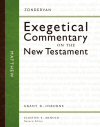
In this volume of the Zondervan Exegetical Commentary on the New Testament series, Grant Osborne offers pastors, students, and teachers a focused resource for reading the Gospel of Matthew. Through the use of graphic representations of translations, succinct summaries of main ideas, exegetical outlines, and other features, Osborne presents the Gospel of Matthew with precision and accuracy.
Grant R. Osborne (PhD, University of Aberdeen) is professor of New Testament at Trinity Evangelical Divinity School in Deerfield, Illinois. He has been at Trinity since 1977. His areas of expertise include the Gospels, hermeneutics, and the book of Revelation. His numerous publications include The Hermeneutical Spiral and commentaries on Revelation, Romans, John, and Matthew.
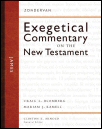
Authors Craig Blomberg and Mariam Kamell use the historical, theological and literary elements of James to guide their interpretation of this often-overlooked early Christian text. Their concise discussion of how the book delivers consistent, challenging instruction will help pastors and church leaders teach the message of James to today’s readers.
Craig L. Blomberg holds a PhD from the University of Aberdeen, Scotland. He is the author, co-author, or co-editor of 15 books and more than 80 articles in journals or multi-author works.
Mariam J. Kamell is a post-doctoral fellow at Regent College, Vancouver. She has published several articles on James focused on its economics or in comparison with Hebrews or 1 Peter; her dissertation focused on soteriology in James in comparison with earlier Jewish wisdom literature and the Gospel of Matthew.
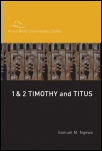
This commentary by Samuel Ngewa is divided into preaching units that contain detailed exposition of the passage as well as contemporary applications. The unit is not intended to be preached as a sermon, but provides material to be drawn on in sermon preparation. Each unit is followed by two or three questions that could be used for a small group or personal study. Academic issues relating to the Greek text and disputes about interpretation are dealt with in the extensive end notes. Africa Bible Commentaries: 1, 2 Timothy and Titus is thus suitable for use as a teaching resource for theological colleges and Bible schools while also being suited to readers who are looking for ways to preach and apply the Scriptures.
Samuel Ngewa received his PhD at Westminster Theological Seminary and is currently professor of New Testament Studies at the Nairobi Evangelical Graduate School of Theology, Kenya. Formerly, he was a faculty member of Scott Theological College.
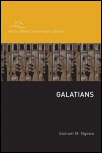
Galatians, the second of the Africa Bible Commentary series preaching commentaries written by Samuel Ngewa, is both a teaching resource for theological colleges and Bible schools all over the country and a Scriptural resource for lay readers to preach and apply God’s Word all over the world.
Samuel Ngewa received his PhD at Westminster Theological Seminary and is currently professor of New Testament Studies at the Nairobi Evangelical Graduate School of Theology, Kenya. Formerly, he was a faculty member of Scott Theological College.
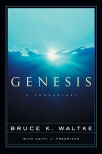
Exploring the first book of the Bible as “theological literature,” Bruce K. Waltke illuminates its meanings and methods for the pastor, scholar, teacher, student, and Bible-lover. Genesis strikes an unusual balance by emphasizing the theology of the Scripture text while also paying particular attention to the flow and development of the plot and literary techniques—inclusion, irony, chiasm, and concentric patterning—that shape the message of the “book of beginnings”.
Bruce K. Waltke, acknowledged to be one of the outstanding contemporary Old Testament scholars, is professor of Old Testament at Reformed Theological Seminary in Orlando, Florida, and professor emeritus of biblical studies at Regent College in Vancouver. He has authored and co-authored numerous books, commentaries, and articles, and contributed to dictionaries and encyclopedias.
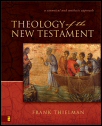
Studying the theology of the New Testament can be a daunting task, even to the knowledgeable Bible student or pastor. Each of the 27 books, written by various authors, has its own theological emphasis and nuances. How do we elicit a coherent message from such theological diversity, especially given that some of the theological statements in the New Testament seem to be at odds with one another? Is such an endeavor achievable or even valid?
Theology of the New Testament takes a balanced approach in response to these challenges. Frank Thielman presents a theology of the New Testament that is careful to take into account the cultural and historical circumstances surrounding each book and the New Testament as a whole. He not only examines each book’s theological content individually, but also in relation to the rest of the New Testament, particularly within each of the three theological units that comprise the New Testament: the Gospels and Acts, the Pauline epistles, and the general epistles and Revelation.
Frank Thielman (PhD, Duke University) is Presbyterian professor of divinity at Beeson Divinity School, Samford University, in Birmingham, Alabama. He is the author of Philippians in the NIV Application Commentary series.
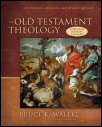
The Old Testament is more than a religious history of the nation of Israel. It is more than a portrait gallery of heroes of the faith. It is even more than a theological and prophetic backdrop to the New Testament. Beyond these, the Old Testament is inspired revelation of the very nature, character, and works of God. As renowned Old Testament scholar Bruce Waltke writes in the preface of this book, the Old Testament’s every sentence is “fraught with theology, worthy of reflection.”
This book is the result of decades of reflection informed by an extensive knowledge of the Hebrew language, the best of critical scholarship, a deep understanding of both the content and spirit of the Old Testament, and a thoroughly evangelical conviction. Taking a narrative, chronological approach to the text, Waltke employs rhetorical criticism to illuminate the theologies of the biblical narrators. Through careful study, he shows that the unifying theme of the Old Testament is the “breaking in of the kingdom of God.” This theme helps the reader better understand not only the Old Testament, but also the New Testament, the continuity of the entire Bible, and ultimately, God himself.
Bruce K. Waltke, acknowledged to be one of the outstanding contemporary Old Testament scholars, is professor of Old Testament at Reformed Theological Seminary in Orlando, Florida, and professor emeritus of biblical studies at Regent College in Vancouver. He has authored and co-authored numerous books, commentaries, and articles, and contributed to dictionaries and encyclopedias.
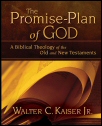
What is the central theme of the Bible? Given the diversity of authorship, genre, and context of the Bible’s various books, is it even possible to answer such a question? Or in trying to do so, is an external grid being unnaturally superimposed on the biblical text? These are difficult questions that the discipline of biblical theology has struggled to answer. In this thoroughly revised and expanded edition of his classic Toward an Old Testament Theology, Walter Kaiser offers a solution to these unresolved issues. He proposes that there is indeed a unifying center to the theology and message of the Bible that is indicated and affirmed by Scripture itself. That center is the promise of God. It is one all-encompassing promise of life through the Messiah that winds itself throughout salvation history in both the Old and New Testaments, giving cohesiveness and unity to the various parts of Scripture.
After laying out his proposal, Kaiser works chronologically through the books of both Testaments, demonstrating how the promise is seen throughout, how the various sub-themes of each book relate to the promise, and how God’s plan to fulfill the promise progressively unfolds. Here is a rich and illuminating biblical theology that will stir the emotion and the intellect.
Walter C. Kaiser Jr. received his PhD from Brandeis University. He is distinguished professor emeritus of Old Testament and president emeritus of Gordon-Conwell Theological Seminary in South Hamilton, Massachusetts. Dr. Kaiser has written over 40 books, including Toward an Exegetical Theology: Biblical Exegesis for Preaching and Teaching; The Messiah in the Old Testament; and The Promise-Plan of God; and co-authored An Introduction to Biblical Hermeneutics: The Search for Meaning.
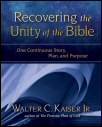
In this volume, Walter Kaiser makes the case for the unity of the Bible. The theological unity of the Bible celebrates the diversity of the Bible, but does so with the conviction that even though that unity can be tested historically, ethically, and otherwise, it has not detracted from the central case for the theological harmony that is found in the text. This has been the general conclusion of two millennia of Judo-Christian exegesis.
Walter C. Kaiser Jr. received his PhD from Brandeis University. He is distinguished professor emeritus of Old Testament and president emeritus of Gordon-Conwell Theological Seminary in South Hamilton, Massachusetts. Dr. Kaiser has written over 40 books, including Toward an Exegetical Theology: Biblical Exegesis for Preaching and Teaching; The Messiah in the Old Testament; and The Promise-Plan of God; and co-authored An Introduction to Biblical Hermeneutics: The Search for Meaning.
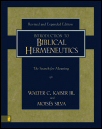
Since its publication in 1994, An Introduction to Biblical Hermeneutics has become a standard text for a generation of students, pastors, and serious lay readers. This second edition has been substantially updated and expanded, allowing the authors to fine-tune and enrich their discussions on fundamental interpretive topics. In addition, four new chapters have been included that address more recent controversial issues:
- The Role of Biblical Theology in Interpretation
- How to Deal With Contemporary Questions Not Directly Addressed in the Bible
- The New Testament’s Use of the Old Testament
- The Role of History in Interpretation
The book retains the unique aspect of being written by two scholars who hold differing viewpoints on many issues, making for vibrant, thought-provoking dialogue. What they do agree on, however, is the authority of Scripture, the relevance of personal Bible study to life, and why these things matter.
Walter C. Kaiser Jr. received his PhD from Brandeis University. He is distinguished professor emeritus of Old Testament and president emeritus of Gordon-Conwell Theological Seminary in South Hamilton, Massachusetts. Dr. Kaiser has written over 40 books, including Toward an Exegetical Theology: Biblical Exegesis for Preaching and Teaching; The Messiah in the Old Testament; and The Promise-Plan of God; and co-authored An Introduction to Biblical Hermeneutics: The Search for Meaning.
Moisés Silva taught biblical studies at Westmont College, Westminster Theological Seminary, and Gordon-Conwell Seminary. He is the author or co-author of eight books, and the revising editor of the Zondervan Encyclopedia of the Bible.
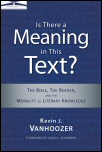
Is There a Meaning in This Text? by Kevin J. Vanhoozer guides the student toward greater confidence in the authority, clarity, and relevance of Scripture, and a well-reasoned expectation to understand accurately the message of the Bible. This volume is a comprehensive and creative analysis of current debates over biblical hermeneutics that draws on interdisciplinary resources, all coordinated by Christian theology. It makes a significant contribution to biblical interpretation that will be of interest to readers in a number of fields.
The intention of the book is to revitalize and enlarge the concept of author–oriented interpretation and to restore confidence that readers of the Bible can reach understanding. The result is a major challenge to the central assumptions of postmodern biblical scholarship and a constructive alternative proposal—an Augustinian hermeneutic—that reinvigorates the notion of biblical authority and finds a new exegetical practice that recognizes the importance of both the reader’s situation and the literal sense.
There is meaning in Vanhoozer's text! Plenty of it, in fact. It is a meaning that traces with a discerning eye the history of authorship and authority, of readership and interpretation—right up to the present time and all under the umbrella of both thinking Christianly and living Christianly. Here is historical, philosophical, and theological exegesis—capped with creative construction—of the first order. As was said to Saint Augustine, on whose thought Vanhoozer builds, Tolle, lege. Take up! Read!
—Robert H. Gundry, Scholar-in-Residence, Westmont College
Kevin J. Vanhoozer, who received his PhD at Cambridge University, is Blanchard Professor of Theology at the Wheaton College and Graduate School. He is the author or editor of 16 books, including The Drama of Doctrine and the forthcoming Remythologizing Theology.
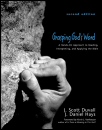
This volume is the revised and updated edition of Grasping God's Word, an indispensable approach to reading, interpreting and applying the Bible that teaches students how to carefully read Scripture in the biblical context, and to dig deeper into the Word of God so they will be able to understand the Bible correctly and apply its meaning to their lives.
It leads students from the most fundamental building blocks of interpretation (including skills that most beginning students lack) through all the essential processes.
—Craig S. Keener, Professor of New Testament, Eastern Seminary
J. Scott Duvall, who received his PhD at Southwestern Baptist Theological Seminary, is professor of New Testament at Ouachita Baptist University. He is the co-author with George H. Guthrie of Biblical Greek Exegesis: A Graded Approach to Learning Intermediate and Advanced Greek and with Terry G. Carter and J. Daniel Hays of the textbook Preaching God's Word: A Hands on Approach to Preparing, Developing and Delivering the Sermon.
J. Daniel Hays is dean of the Pruet School of Christian Studies and professor of Old Testament at Ouachita Baptist University. He is the author of From Every People and Nation, and he has co-authored Grasping God's Word; Preaching God's Word; Journey into God’s Word; The Story of Israel: A Biblical Theology; Iraq: Babylon of the End Times?; Apocalypse; and The Dictionary of Biblical Prophecy. He teaches adult Sunday school at his local church in Arkadelphia, Arkansas, and preaches frequently throughout the nation.
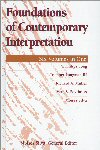
Foundations of Contemporary Interpretation
- Editor: Moisés Silva
- Publisher: Zondervan
- Publication Date: 1996
- Pages: 690
Foundations of Contemporary Interpretation by Moisés Silva seeks to identify and clarify the basic problems of interpretation that affect our reading of the Bible today. This unique volume provides a comprehensive and systematic coverage of the field of general hermeneutics. Foundations of Contemporary Interpretation examines the impact of specific academic disciplines on the interpretation of the Bible. Previously published as separate volumes, its various sections explore the interface between hermeneutics and literary criticism, linguistics, history, science, and theology. Included in Foundations of Contemporary Interpretation.
- Has the Church Misread the Bible?, by Moisés Silva
- Literary Approaches to Biblical Interpretation, by Tremper Longman III
- God, Language, and Scripture, by Moisés Silva
- The Art of Biblical History, by V. Philips Long
- Science and Hermeneutics, by Vern S. Poythress
- The Study of Theology, by Richard A. Muller.
It leads students from the most fundamental building blocks of interpretation (including skills that most beginning students lack) through all the essential processes.
—Craig S. Keener, Professor of New Testament, Eastern Seminary
Moisés Silva taught biblical studies at Westmont College, Westminster Theological Seminary, and Gordon-Conwell Seminary. He is the author or co-author of eight books, and the revising editor of the Zondervan Encyclopedia of the Bible.
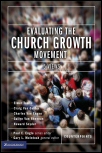
What exactly is church growth? In what ways has the movement actually brought growth to the church, and how effective has it been in doing so? What are its strengths and weaknesses? This timely book addresses such questions. After providing a richly informative history and overview, it explores—in a first-ever roundtable of their leading voices—five main perspectives, both pro and con, on the classic Church growth movement.
Contents and contributors:
- “Effective Evangelism View,” by Elmer Towns
- “Gospel in Our Culture View,” by Craig Van Gelder
- “Centrist View,” by Charles Van Engen
- “Reformist View,” by Gailyn Van Rheenan
- “Renewal View,” by Howard Snyder
Dr. Gary L. McIntosh teaches at Talbot School of Theology, is a professor of Christian ministry and leadership, leads 20-25 national seminars a year, serves as a church consultant, was president of the American Society of Church Growth in 1995–1996, and has written over 95 articles and 10 books, including Finding Them, The Issachar Factor, Three Generations, One Size Doesn’t Fit All, Overcoming the Dark Side, and Staffing Your Church for Growth.
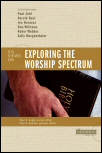
This volume outlines a clear, engaging description of the six most prevalent models of worship in North American churches, presented by advocates for each position. The contributors evaluate each position in order to broaden people’s understanding of diverse models and shed light on an emotive issue.
Contents and contributors:
- “Formal-Liturgical,” by Paul Zahl
- “Traditional Hymn-Based,” by Harold Best
- “Contemporary Music-Driven,” by Joe Horness
- “Charismatic,” by Don Williams
- “Blended,” by Robert Webber
- “Emerging,” by Sally Morgenthaler
Six different writers each present a chapter on their particular worship—running the gamut from formal liturgical, to charismatic, to emerging worship. Each chapter is followed by short commentaries by the other writers providing a variety of perspectives on each worship style. What emerges is a fascinating conversation that doesn't try to convert you to one particular style of worship, but broadens your mind to the inherent worth of different types of worship. A good read.
—YouthWorker Journal
Paul Basden is one of the senior pastors at Preston Trail Community Church in Frisco, Texas. He has also served as pastor of other churches in Alabama and Texas and as an adjunct professor at Beeson Divinity School. He is a graduate of Baylor University and Southwestern Baptist Theological Seminary and the author of The Worship Maze.
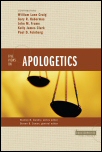
Contents and contributors:
- “Classical Aplogetics,” by William Lane Craig
- “Evidential Apologetics,” by Gary R. Habermas
- “Cumulative Case Apologetics,” by Paul D. Feinberg
- “Presuppositional Apologetics,” by John M. Frame
- “Reformed Epistemology Apologetics,” by Kelly James Clark
Steven B. Cowan, MDiv, PhD, is associate professor of philosophy and apologetics at Southeastern Bible College in Birmingham, AL.
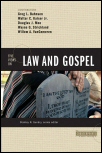
Do the Law and the Gospel belong to two separate dispensations? Has the Gospel replaced the Law? What is the relevance of the Old Testament Law to our lives as Christians? Is there continuity between it and what Christ expects of us in the Gospel? It is no secret that Christians have differed widely on these questions. This book explores five major approaches to this important biblical topic that have developed in Protestant circles. Each of the five authors presents his particular perspective on the issue and responds to the other four.
Contents and contributors:
- “The Law is the Perfection of Righteousness in Jesus Christ: A Reformed Perspective,” by Willem A. Vangemeron
- “The Theonomic Reformed Approach to Law and Gospel,” by Greg L. Bahnsen
- “The Law as God's Gracious Guidance for the Promotion of Holiness,” by Walter C. Kaiser Jr.
- “The Inauguration of the Law of Christ with the Gospel of Christ: A Dispensational View,” by Wayne G. Strickland
- “The Law of Christ as the Fulfillment of the Law of Moses: A Modified Lutheran View,&dquo; by Douglas Moo
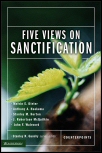
Christians generally recognize the need to live a holy, or sanctified, life. But they differ on what sanctification is and how it is achieved. Five Views on Sanctification brings together in one easy-to-understand volume five major Protestant views on sanctification. Writing from a solid evangelical stance, each author describes and defends his own understanding of the doctrine, and responds as well to the views of the other authors.
This book addresses such practical questions as: How does one achieve sanctification in this life? How much success in sanctification is possible? Is a crisis experience following one’s conversion normal—or necessary? If so, what kind of experience, and how is it verified?
Contents and contributors:
- “The Wesleyan Perspective,” by Melvin E. Dieter
- “The Reformed Perspective,” by Anthony A Hoekema
- “The Pentecostal Perspective,” by Stanley M. Horton
- “The Keswick Perspective,” by J. Robertson McQuilkin
- “The Augustinian-Dispensational Perspective,” by John F. Walvoord
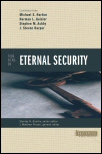
Does the Bible support the concept of “once saved, always saved,” or can a person lose his or her salvation? How do the Scriptures portray the complex interplay between grace and free will? These and related questions are explored from different angles in this thought-provoking Counterpoints volume.
The contributors each state their case for one of four prominent views on eternal security: classical Calvinist, moderate Calvinist, reformed Arminian, and Wesleyan Arminian. In keeping with the forum approach of the Counterpoints series, each view is first presented by its proponent, then critiqued and defended. This fair and respectful approach allows you to weigh for yourself the strengths and weaknesses of the different doctrinal stances. By furnishing you with scholarly and thoughtful perspectives on the topic of eternal security, this book helps you sift through opposing views to arrive at your own informed conclusions.
Contents and contributors:
- “A Classical Calvinist View,” by Michael S. Horton
- “A Moderate Calvinist View,” by Norman L. Geisler
- “A Reformed Arminian View,” by Stephen M. Ashby
- “A Wesleyan Arminian View,” by J. Steven Harper
J. Matthew Pinson is president of Free Will Baptist Bible College in Nashville, Tennessee.
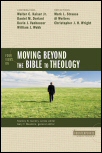
The Bible has long served as the standard for Christian practice, yet believers still disagree on how biblical passages should be interpreted and applied. Only when readers fully understand the constructs that inform their process of moving from Scripture to theology—and those of others—can Christians fully evaluate teachings that claim to be “biblical.” Here, scholars who affirm an inspired Bible, relevant and authoritative for every era, present models they consider most faithful to Scripture.
Contents and contributors:
- “A Principlizing Model,” by Walter C. Kaiser Jr.
- “A Redemptive-Historical Model,” by Daniel M. Doriani
- “A Drama-of-Redemption Model,” by Kevin J. Vanhoozer
- “A Redemptive-Movement Model,” by William J. Webb
Moreover, due to the far-reaching implications this topic holds for biblical studies, theology, and church teaching, this book includes three additional reflections by Christopher J. H. Wright, Mark L. Strauss, and Al Wolters on the theological and practical interpretation of biblical texts.
Gary T. Meadors is professor of Greek and New Testament at Grand Rapids Theological Seminary. He is author of Decision Making God’s Way and a contributor to the Evangelical Dictionary of Biblical Theology.
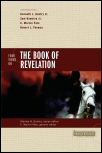
Is the book of Revelation a blueprint for the future that needs decoding if we want to understand current events? Is it a book of powerful imagery, with warnings and promises for the church throughout the ages? Or is it essentially an imaginative depiction of historical events in the first century? Four Views on the Book of Revelation explores the four main views in which Revelation is understood: preterist, idealist, classical dispensationalist futurist, and progressive dispensationalist.
Contents and contributors:
- “A Preterist View of Revelation,” by Kenneth L Gentry Jr.
- “An Idealist View of Revelation,” by Sam Hamstra Jr.
- “A Progressive Dispensationalist View of Revelation,” by C. Marvin Pate
- “A Classical Dispensationalist View of Revelation,” by Robert L. Thomas
C. Marvin Pate taught for 13 years at Moody Bible Institute. Now he is chair of the department of Christian theology and professor of theology at Ouachita Baptist University. Pate has authored, co-authored, or edited 20 books.
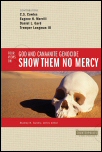
Christians are often shocked to read that Yahweh, the God of the Israelites, commanded the total destruction—all men, women, and children—of the ethnic group known as the Canaanites. This seems to contradict Jesus’ command in the New Testament to love your enemies and do good to all people. How can Yahweh be the same God as the Father of our Lord Jesus Christ? What does genocide in the Bible have to do with the politics of the twenty-first century? This book explores, in typical Counterpoints format, the Old Testament command of God to exterminate the Canaanite population and what that implies about continuity between the Old and New Testaments.
Contents and contributors:
- “Strong Discontinuity,” by C. S. Cowles
- “Moderate Discontinuity,” by Eugene H. Merrill
- “Spiritual Continuity,” by Daniel L. Gard
- “Eschatological Continuity,” by Tremper Longman III
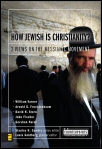
Are Messianic congregations necessary or should Jewish believers be incorporated into the Gentile church? The question of how Christian Jews relate their Jewish practices and customs to the church has been an issue within Christianity since the first century. Contemporary contributors who have lived and wrestled with this issue present informed arguments and counter-arguments. The book concludes with a chapter on the future for Messianic Jews and a directory of messianic movement organizations.
Contents and contributors:
- “Messianic Congregations are not Necessariy,” William Varner
- “Messianic Congregations May Exist within the Body of Messiah, as Long as They Don't Function Contrary to the New Testament,” by Arnold G. Fruchtenbaum
- “The Future of Messianic Judaism,” by David Stern
Louis Goldberg is one of the foremost Messianic Jewish authors in the world. He has written 14 books and numerous articles for encyclopedias, worked on the translation of the New International Version of the Bible; and consulted on the New King James Bible. He received his ThM from Northern Baptist Theological Seminary and his ThD from Grace Theological Seminary. He is former Professor of Theology and Jewish Studies at Moody Bible Institute.

Among born-again Christians, 27 percent have experienced divorce as compared to 24 percent in the general population. Yet no consensus exists among evangelicals on their views of remarriage, leaving many Christians confused. This single volume summarizes and explores three main evangelical views: no remarriage, remarriage after adultery or desertion, and remarriage for a variety of reasons. Each of the three contributors offers his point of view succinctly with biblical support, and each interacts with the others to help readers come to their own conclusions.
Contributors and contents:
- “No Remarriage After Divorce,” by Gordon J. Wenham
- “Remarriage (two grounds),” by William A. Heth
- “Remarriage (variety of reasons),” by Craig S. Keener
Mark Strauss is professor of New Testament at Bethel Seminary in San Diego. He has written The Davidic Messiah in Luke-Acts, Distorting Scripture?, The Challenge of Bible Translation and Gender Accuracy, and Luke in the Zondervan Illustrated Bible Background Commentary series. Forthcoming books include The Gospels and Jesus, Mark in the revised Expositor's Bible Commentary series, and Mark in the Zondervan Exegetical Commentary series.
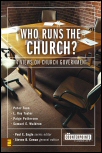
Churches have split and denominations have formed over the issue of church government. Yet while many Christians can explain their particular church’s form of rule and may staunchly uphold it, few have a truly biblical understanding of it. What model for governing the church does the Bible provide? Is there room for different methods? Or is just one way the right way? In Who Runs the Church? four predominant approaches to church government are presented by respected proponents.
Contents and contributors:
- “Episcopalianism,” by Peter Toon
- “Presbyterianism,” by L. Roy Taylor
- “Single-Elder Congregationalism,” by Paige Patterson,
- “Plural-Elder Congregationalism,” by Samuel E. Waldron
Steven B. Cowan (MDiv, PhD) is associate professor of philosophy and apologetics at Southeastern Bible College in Birmingham, Alabama.
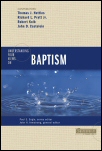
What is the significance of water baptism? Who should be baptized? Is infant baptism scriptural? Which is the proper baptismal mode: sprinkling, pouring, or immersion? Should people be re-baptized if they join a church that teaches a different form of baptism? Should baptism be required for church membership? These and other questions are explored in this thought-provoking book.
Contents and contributors:
- “Baptist View: Baptism as a Symbol of Christ's Saving Work,” by Thomas J. Nettles
- “Reformed View: Baptism as a Sacrement of the Covenant,” by Richard L. Pratt Jr.
- “Lutheran View: God's Baptismal Act as Regenerative,” by Robert Kolb
- “Christian Churches/Churches of Christ View: Believers' Baptism as the Biblical Occasion of Salvation,” by John D. Castelein
John H. Armstrong is president of ACT 3 in Carol Stream, Illinois and served as a pastor for more than 20 years. He is an adjunct professor of evangelism at Wheaton College Graduate School. His online commentaries regularly appear at www.Act3online.com. He holds degrees from Wheaton College, Wheaton Graduate School, and Luther Rice Seminary. He is the author or editor of a number of books including The Catholic Mystery, Five Great Evangelists, and Understanding Four Views on the Lord’s Supper.
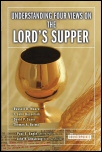
Who should participate in the Lord’s Supper? How frequently should we observe it? What does this meal mean? What happens when we eat the bread and drink from the cup? What do Christians disagree about and what do they hold in common? This volume in the Counterpoints: Church Life series allows four contributors to make a case for the following views: Baptist, Reformed, Lutheran, and Roman Catholic.
Contents and contributors:
- “Baptist View: Christ's Presence as a Memorial,” by Russell D. Moore
- “Reformed View: The Real Presence of Christ,” by I. John Hesslink
- “Lutheran View: Finding the Right Word,” by David P. Scaer
- “Roman Catholic View: Christ's True, Real, and Substantial Presence,” by Thomas A. Baima
John H. Armstrong is president of ACT 3 in Carol Stream, Illinois and served as a pastor for more than 20 years. He is an adjunct professor of evangelism at Wheaton College Graduate School. His online commentaries regularly appear at www.Act3online.com. He holds degrees from Wheaton College, Wheaton Graduate School, and Luther Rice Seminary. He is the author or editor of a number of books including The Catholic Mystery, Five Great Evangelists, and Understanding Four Views on Baptism.
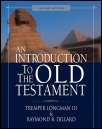
This second edition of An Introduction to the Old Testament integrates and interacts with recent developments in Old Testament scholarship. It has been revised and updated to reflect recent advances in Old Testament scholarship. An upper-level introduction that includes callouts, charts, and graphs, it offers a solid understanding of three key issues: historical background, literary analysis, and theological message.
Raymond B. Dillard was professor of Old Testament language and literature at Westminster Theological Seminary.
Tremper Longman III is an Old Testament scholar and award-winning author. He earned degrees from Ohio Wesleyan University, Westminster Theological Seminary, and Yale University. He taught for 18 years at Westminster in Philadelphia before becoming a professor of biblical studies and chair of the religious studies department at Westmont College.
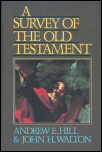
The purpose of studying the Old Testament is to understand God and his redemptive work more fully. However, this goal is complicated by the fact that it was transmitted through a very different language and culture from our own. A Survey of the Old Testament provides an indispensable guide for undergraduate students and other readers by exploring the literary, historical, and theological issues behind the Old Testament and its various books.
For each Old Testament book, the Survey addresses background information, purpose, message, structure, and major themes. Chapters introducing each major section of the Old Testament are included, as are chapters dealing with issues of interpretation, geography, archaeology, history, formation of the Old Testament canon, and the Old Testament’s relationship to the New Testament. The text is enhanced throughout by maps, photos, timelines, and charts. This full-color third edition of a widely acclaimed textbook has been expanded and redesigned in both text and graphical elements, making it even more beneficial.
Andrew E. Hill PhD, University of Michigan) is professor of Old Testament studies at Wheaton College in Illinois. He is the author of Malachi in the Anchor Bible commentary series. His articles have appeared in such scholarly publications as Hebrew Annual Review, Journal of Biblical Literature, and Vetus Testamentum.
John H. Walton (PhD, Hebrew Union College) is professor of Old Testament at Wheaton College Graduate School. He is the author or co-author of several books, including Chronological and Background Charts of the Old Testament; Ancient Israelite Literature in Its Cultural Context; Covenant: God’s Purpose, God’s Plan; and The IVP Bible Background Commentary: Old Testament.
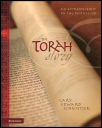
Working knowledge of the Torah is essential for every serious student of the Scriptures. Written in an engaging and accessible voice, even while digging into difficult and complicated matters at a sophisticated level, The Torah Story emphasizes the content of the text itself, moving beyond debating dates and theories of authorship into understanding how these five key books of the Bible help us understand the story of salvation. Providing flexible options for further study, each chapter includes the following:
- Tips and tools for getting started
- Questions that focus on key issues Key terms to look for
- Outlines and summaries of the material
- An interactive workshop designed for students, individuals, or study groups
- Challenge questions drawn from the chapter and biblical text
- Advanced questions for those who want deeper exploration of biblical contexts, language, and exegetical or theological issues
- Research project suggestions
- Discussion activities using films to engage the biblical narrative
Andrew E. Hill PhD, University of Michigan) is professor of Old Testament studies at Wheaton College in Illinois. He is the author of Malachi in the Anchor Bible commentary series. His articles have appeared in such scholarly publications as Hebrew Annual Review, Journal of Biblical Literature, and Vetus Testamentum.
John H. Walton (PhD, Hebrew Union College) is professor of Old Testament at Wheaton College Graduate School. He is the author or co-author of several books, including Chronological and Background Charts of the Old Testament; Ancient Israelite Literature in Its Cultural Context; Covenant: God’s Purpose, God’s Plan; and The IVP Bible Background Commentary: Old Testament.
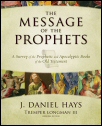
Christians sometimes approach the Old Testament with a mixture of awe and bewilderment, knowing that it contains pearls of wisdom, but unsure how to dive for them—especially when it comes to the Prophets. In The Message of the Prophets, author J. Daniel Hays offers a scholarly, yet readable and student-friendly survey of the Old Testament prophetic literature that presents the message of each prophet in its historical and its biblical context and then tracks that message through the New Testament to challenge readers with what it means for them today.
Hays focuses on synthesizing the message of the prophets, which enables students to grasp the major contours of the prophetic books clearly and concisely. Hundreds of colorful pictures help to illustrate the historical and cultural background of the prophets. After identifying what the message meant for ancient Israel, Hays helps the readers to move toward theological application today, helping readers to gain a better understanding of God and the relationship between God and his people. The Message of the Prophets is essential for professors, students, and others seeking to understand the role that the Old Testament prophets play in the Christian faith.
J. Daniel Hays is dean of the Pruet School of Christian Studies and professor of Old Testament at Ouachita Baptist University. He is the author of From Every People and Nation, and he has co-authored Grasping God's Word; Preaching God's Word; Journey into God’s Word; The Story of Israel: A Biblical Theology; Iraq: Babylon of the End Times?; Apocalypse; and The Dictionary of Biblical Prophecy. He teaches adult Sunday school at his local church in Arkadelphia, Arkansas, and preaches frequently throughout the nation.
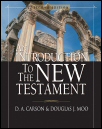
An Introduction to the New Testament focuses on “special introduction” that is historical questions dealing with authorship, date, sources, purpose, destination, and so forth. This approach stands in contrast to recent texts that concentrate more on literary form, rhetorical criticism, and historical parallels—topics the authors don’t minimize, but instead think are better given extended treatment in exegesis courses. By refocusing on the essentials, An Introduction to the New Testament ensures that the New Testament books will be accurately understood within historical settings. For each New Testament document, the authors also provide a substantial summary of that book’s content, discuss the book’s theological contribution to the overall canon, and give an account of current studies on that book, including recent literary and social-science approaches to interpretation.
[. . . . ]highly recommended. With its very careful, keenly nuanced, and extensively researched discussions, it may well be considered special in a way not originally intended by its authors. It deserves to be read not just by students but by all scholars of the New Testament.
D. A. Carson is research professor of New Testament at Trinity Evangelical Divinity School in Deerfield, Illinois. He is the author or co-author of over 50 books, including the Gold Medallion Award-winning book The Gagging of God.
Douglas Moo is the Blanchard Professor of New Testament at Wheaton College. His work centers on understanding the text of the New Testament and its application today. He has written extensively in several commentary series, including the NIV Application Commentary and the Pillar Commentary.
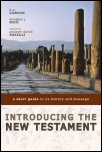
This abridged edition of an established major textbook brings the best of New Testament scholarship to the church and makes it accessible to the average reader. Focusing on historical questions dealing with authorship, date, sources, purpose, and destination of the New Testament books, this book will help a new generation of students and church leaders better grasp the message of the New Testament.
This book focuses on historical questions dealing with authorship, date, sources, purpose, and destination of the New Testament books. By focusing on the essentials, the authors ensure that each book is accurately understood within its historical settings. For each New Testament document, the authors also provide a summary of that book’s content and discuss the book’s theological contribution to the overall canon.
D. A. Carson is research professor of New Testament at Trinity Evangelical Divinity School in Deerfield, Illinois. He is the author or co-author of over 50 books, including the Gold Medallion Award-winning book The Gagging of God.
Douglas Moo is the Blanchard Professor of New Testament at Wheaton College. His work centers on understanding the text of the New Testament and its application today. He has written extensively in several commentary series, including the NIV Application Commentary and the Pillar Commentary.
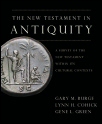
The New Testament in Antiquity is a textbook for college and seminary students penned by three evangelical scholars with over 50 years of combined experience in the classroom. Their challenge was to build a text that would be engaging, academically robust, richly illustrated, and relevant to the modern student. This book strikes a balance between being accessible to all students and challenging them to explore the depths of the New Testament within its cultural worlds.
This volume carefully develops how Jewish and Hellenistic cultures formed the essential environment in which the New Testament authors wrote their books and letters. It argues that knowing the land, history, and culture of this world brings remarkable new insights into how we read the New Testament itself. Numerous sidebars provide windows into the Jewish, Hellenistic, and Roman worlds and integrate this material directly with the interpretation of the literature of the New Testament. This is an ideal introductory text for classroom use, with ample discussion questions and bibliographies.
Gary M. Burge is a professor of New Testament in the Department of Biblical and Theological Studies at Wheaton College and Graduate School. Gary has authored a number of books, including Who Are God’s People in the Middle East? What Christians Are Not Being Told About Israel and the Palestinians.
Lynn H. Cohick is associate professor of New Testament in the Department of Biblical and Theological Studies at Wheaton College and Graduate School, Wheaton, Illinois.
Gene L. Green is Professor of New Testament at Wheaton College and Graduate School. Before coming to Wheaton in 1996, he served for over a decade as professor of New Testament as well as academic dean and rector of the Seminario ESEPA in San José, Costa Rica.
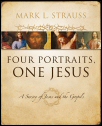
To Christians worldwide, the man Jesus of Nazareth is the centerpiece of history, the object of faith, hope, and worship. Even those who do not follow him admit the vast influence of his life. For anyone interested in knowing more about Jesus, study of the four biblical Gospels is essential.
Four Portraits, One Jesus is a thorough yet accessible introduction to these documents and their subject, the life and person of Jesus. Like different artists rendering the same subject using different styles and points of view, the Gospels paint four highly distinctive portraits of the same remarkable Jesus.
Mark Strauss is professor of New Testament at Bethel Seminary in San Diego. He has written The Davidic Messiah in Luke-Acts, Distorting Scripture?, The Challenge of Bible Translation and Gender Accuracy, and Luke in the Zondervan Illustrated Bible Background Commentary series. Forthcoming books include The Gospels and Jesus, Mark in the revised Expositor's Bible Commentary series, and Mark in the Zondervan Exegetical Commentary series.
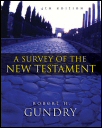
This revised edition of Robert H. Gundry’s survey of the New Testament goes beyond providing background information and technical introductory material and leads students to read the New Testament itself. Whenever possible general questions of introduction and background are tied to assigned readings covering the entire New Testament. In addition, comments on these readings help students with interpretation and follow the flow of thought from one passage to another.
Robert H. Gundry is a scholar-in-residence and professor emeritus of New Testament and Greek at Westmont College in Santa Barbara, California. Among his books are Mark: A Commentary on His Apology for the Cross; Matthew: A Commentary on His Handbook for a Mixed Church Under Persecution, Soma in Biblical Theology, and Jesus the Word According to John the Sectarian.
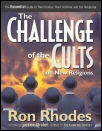
In this essential resource, preeminent cult authority Ron Rhodes explains what cults are, why they are cause for concern, and why in the 21st century, as never before, their numbers and memberships are exploding nationally and worldwide. Drawing on his extensive experience as a cult researcher, Rhodes offers to-the-point, cutting-edge information on 12 major cults and new religions.
Ron Rhodes is the president of Reasoning from the Scriptures Ministries. He is the author of 18 books, including two Silver Medallion Award winners. He is heard nationwide on radio.
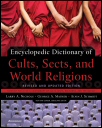
Encyclopedic Dictionary of Cults, Sects, and World Religions is arguably the most significant reference book on the subject to be published. Formerly titled Dictionary of Cults, Sects, Religions, and the Occult, it provides reliable information on the history and beliefs of nearly every form of religion active today. This extensively revised edition includes new topics, updated information, and a brand-new format for a clearer, more organized approach.
Larry A. Nichols is the pastor of Our Redeemer Evangelical Lutheran Church in Greenville, Rhode Island. He is co-author of Masonic Lodge in the Zondervan Guide to Cults and Religious Movements.
George A. Mather is the pastor of Our Savior Lutheran Church in St. George, Utah, and is the co-author of Encyclopedia Dictionary of Cults, Sects, and World Religions.
Alvin J. Schmidt retired in 1999 as professor of sociology at Illinois College in Jacksonville, Illinois, where he still lives. He is the author of several books, including The Great Divide: The Failure of Islam and the Triumph of the West, and served as a consulting editor for Dictionary of Cults, Sects, Religions and the Occult.
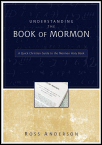
A former Mormon and an adult convert to Christianity, author Ross Anderson provides a clear summary of the Book of Mormon including its history, teachings, and unique features. Stories from the author and other ex-Mormons illustrate the use of Mormon scripture in the Latter-day Saint church. Anderson gives special attention to how the Book of Mormon relates to Christian beliefs about God, Jesus, and the Bible.
Ross Anderson is the founding pastor of Wasatch Evangelical Free Church in Roy, Utah, where he has served since graduating from seminary in 1983. He was born in Utah and raised in California as an active member of the Mormon Church. He is passionate about incorporating ex-Mormons into the Church.
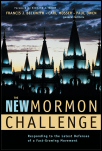
Written by an international team of respected Christian scholars, this freshly researched rebuttal of Mormon truth will aid those sharing the Gospel with Mormons and those investigating Mormonism on their own. It will help readers to accurately understand Mormonism through biblical, historical, scientific, philosophical, and theological discussions.
I applaud the sensitivity and understanding invested in this enormous work.
—Ravi Zacharias
Francis J. Beckwith is professor of philosophy and church-state studies, and codirector of the program in philosophical studies of religion in the Institute for Studies of Religion, at Baylor University in Waco, Texas. A graduate of Fordham University and the Washington University School of Law, St. Louis, his books include Law, Darwinism, and Public Education: The Establishment Clause ad the Challenge of Intelligent Design, To Everyone An Answer: A Case for the Christian Worldview, and Do the Right Thing: Readings in Applied Ethics & Social Philosophy.
Carl Mosser has published significant articles on Mormonism in both evangelical and Mormon journals.
Paul Owen is assistant professor of Bible and religion at Montreat College. He has published significant articles on Mormonism in both evangelical and Mormon journals. He lives in Asheville, North Carolina.
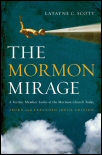
In the first edition of The Mormon Mirage, Latayne C. Scott shared her remarkable journey out of Mormonism as she uncovered shocking inaccuracies, inconsistencies, and contradictions in the faith she had loved and lived. 30 years later, Mormonism and Mormon scholarship have evolved with the times. In this third, revised and updated edition of her well-known book, Scott keeps pace with changes and advances in Mormonism, and reveals formidable new challenges to its claims and teachings.
I applaud the sensitivity and understanding invested in this enormous work.
—Ravi Zacharias
Latayne C. Scott was Mormon for 10 years, attending Brigham Young University on a writing scholarship and working as a staff member for two of BYU’s weekly magazines. She is the author of 14 published books, including Latter-Day Cipher, Why We Left Mormonism, and The Hinge of Your History: The Phases of Faith. She has also published articles and poems in secular magazines and in major Christian magazines, and she is the recipient of Pepperdine University's “Distinguished Christian Service Award” for her writing.
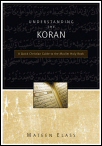
This volume is a quick non-technical, introduction to the Koran designed to help Christians understand a hidden book revered by 1.3 billion Muslims, covering the background on its writing, a summary of its contents, a perspective on how it’s used and viewed by Muslims, a comparison of differences and similarities to the Bible, and some suggestions on how it should and should not be used in conversations with Muslims. Find out how the Koran resembles the Bible—and the drastic ways in which it differs. Understanding the Koran gives you a fascinating essential grasp of Islam’s holy book: where it came from, what it teaches, how Muslims view it, and how the Allah of the Koran compares with the God of the Bible.
Mateen Elass was raised in Saudi Arabia in a Muslim environment. He holds degrees from Stanford University, Fuller Theological Seminary, and a PhD from the University of Durham in England. He has served in a church in Colorado and currently serves as senior pastor of a Presbyterian church in the Midwest. He has written feature articles for Moody magazine, including “What Muslims Think of America.”
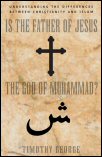
Today as never before, the world’s second largest religion is shaping our culture, and words such as jihad, imam, Quran, and fatwa have entered our vocabulary. While all Muslims are no more alike than all Christians are alike, there are certain fundamental beliefs that all Muslims hold in common—some of which Christians would agree with, including belief in one true God. But is it the same God? How does the God of Muhammad differ from the God of Christianity?
Written in a clear, passionate style that is conciliatory, balanced, and uncompromisingly biblical, this book describes and contrasts the distinctives of Christianity and Islam. Its author, a noted historian and theologian who has studied Islam for many years, writes with an eye on helping Christians better understand how to interact with Muslims.
Timothy George is the founding dean of Beeson Divinity School of Samford University. An executive editor of Christianity Today, Timothy George has written more than 20 books and regularly contributes to scholarly journals.
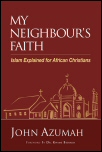
Nowhere else in the world have both Islam and Christianity been more instrumental in shaping the history of a people and their way of life than in Africa. African Muslims and Christians have a lot in common, including kinship ties, shared languages and citizenship. Yet, despite the centuries of deep historical links and harmonious existence between the two religions, new challenges threaten this harmony. Conflicts involving Christians and Muslims in places like Sudan, Nigeria and Ivory Coast are common. These conflicts are fueled primarily by ignorance, stereotyping and prejudice, which in turn breed fear, suspicion and even hatred, in some cases leading to violence.
My Neighbour’s Faith sheds light on the beliefs and teaching of Islam by addressing matters of contemporary importance to Christians and the wider non-Muslim audience. It presents the human face of Islam—the face of a close relative, a neighbour, a teacher and even a head of state—in a balanced and critical way that gives a credible view of Islam.
John Azumah holds a PhD in Islamics from the University of Birmingham, UK, and is the Director for the Centre of Islamic Studies at the London School of Theology. He has previously served as a research fellow with the Akrofi-Christaller Institute in Ghana. Dr. Azumah is the author of The Legacy of Arab-Islam in Africa: A Quest for Inter-Religious Dialogue and has written articles on the subject in various academic journals.
Reviews
1 rating
Randy Kyle
6/7/2017
Dynamic Pricing is a sham. New to Me books will cost me $909 but if sold separately, I can get it for $728. That and the fact that on one package I was looking at, Logos didnt even notify me that I had half the books - and it there wasn't a dynamic price. This is the equivalent of theft.Michael T. Regan
5/21/2014